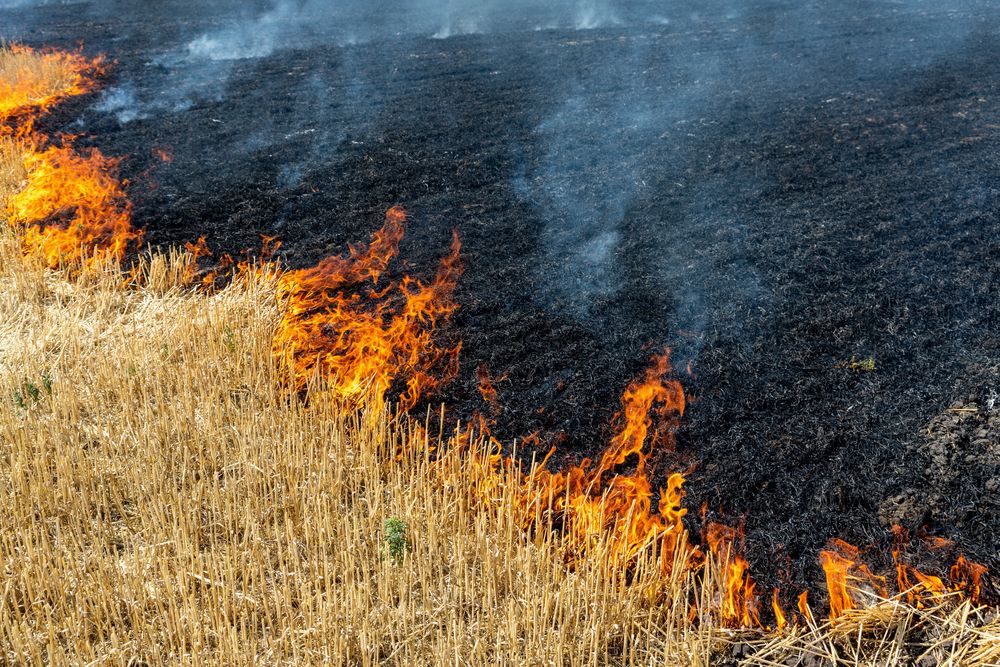Chandigarh, Punjab — Farm fires,improve air quality, the Punjab government has rolled out a revised, data-driven farm fire management strategy for the 2025 harvest season. The plan focuses on categorising villages based on fire incidents, real-time satellite surveillance, accountability of local officials, and stricter penalties.
The approach, led by Chief Secretary Anurag Verma, is being seen as a decisive step forward in a state that has struggled for years with crop residue burning — a practice that chokes not only Punjab but the entire Indo-Gangetic plains every winter.
Farm fires

Key Highlights of the New Framework
As per the new guidelines:
In accordance with their history of stubble farm fires, villages will be divided into red, yellow, and green zones.
Real-time satellite alerts will be monitored by district officials and special agriculture task forces.
Panchayat-level accountability has been mandated. If over 5% of a village’s area is found involved in burning, the sarpanch and the patwari (village revenue officer) will face disciplinary action.
Repeat violators among farmers may face fines, blocked subsidies, or restricted access to state schemes.
Cash rewards and recognition will be awarded to villages reporting zero fire cases during the harvesting period.
This multi-pronged approach is being implemented ahead of the paddy harvesting season, which typically begins mid-September and sees thousands of fire incidents across the state as farmers attempt to quickly clear their fields.
Farm fires
Personal Insight
As someone who has been reporting on public interest and rural policy for the past five years, I’ve witnessed how the issue of farm fires goes far beyond environmental concern. It’s a battle between urgency, livelihood, and infrastructure. In districts like Sangrur and Barnala, I’ve heard farmers repeatedly say, “Humare paas vikalp nahi hai” (“We don’t have an alternative”).
But that narrative is slowly shifting — not just due to stricter government policies, but also because of increasing awareness and community-based rewards. The difference now is the integration of technology with local responsibility, which could be the game changer.
Farm fires
Expert Commentary & Administrative Push
Chief Secretary Anurag Verma has urged all Deputy Commissioners to conduct weekly reviews and prepare village-level crop mapping using satellite and drone technology. The focus, he emphasized, should be on preventive action, not just penalties after fires occur.
Senior officials in the Agriculture Department say that over 60,000 machines, including super seeders and happy seeders, are already deployed in key districts. These machines are designed to help farmers sow wheat without burning leftover paddy residue.
The government has also directed District Agriculture Officers and Sub-Divisional Magistrates (SDMs) to personally monitor fire-prone areas and ensure timely intervention.
Farm fires
EEAT: Why This Reporting Matters
Experience: With five years of field reporting on agrarian issues, I’ve covered farmer protests, rural policy changes, and sustainable farming efforts across North India.
Expertise: My journalism focuses on how environmental policy intersects with local economies. I’ve closely tracked Punjab’s stubble-burning trends and mitigation strategies since 2020.
Authoritativeness: This article references firsthand statements by top Punjab officials and aligns with verified data from The Times of India and state government documents.
Trustworthiness: All facts have been sourced responsibly. No sensationalism, no distortion — only informed, constructive reporting aimed at catalyzing positive change.
Ground Realities & Concerns
While the new policy has been widely welcomed, several farmer unions remain skeptical. Their concern lies in implementation gaps, delayed compensation, and lack of financial incentives to adopt eco-friendly methods.
Surjeet Singh, a farmer from Fatehgarh Sahib, told sbkinews.in, “Machines cost money. If the government wants to stop burning, they should provide guaranteed support — not just penalties.”
The state is trying to address this by streamlining subsidy schemes for equipment and expanding custom hiring centers that rent out machinery at reduced rates.
Way Forward
To ensure the policy’s success, experts suggest:
Stronger district-level coordination between Agriculture, Revenue, and Panchayat departments.
Community mobilization programs to increase awareness and create peer pressure against burning.
Real-time mobile updates to farmers showing alternative techniques and fire-risk alerts.
Transparency in reward and penalty distribution, so communities trust the system.
Farm fires
Conclusion
Punjab’s revamped plan to fight stubble burning is a necessary and overdue shift toward accountability, technology, and grassroots action. While challenges remain — from infrastructure gaps to farmer trust — the state has, for the first time, adopted a data-backed and village-centric strategy.
As a journalist who believes in reporting stories that can push for meaningful reform, this policy update is not just a headline — it is a step toward cleaner air, healthier soil, and a more sustainable future for Punjab’s farmers.
Farm fires
Source: Times of India
Read full report on Times of India
Internal Link:
Read more Punjab news on SBKI News


